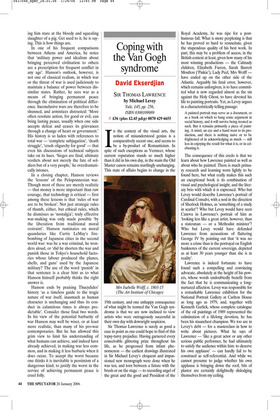Coping with the Van Gogh syndrome
David Ekserdjian
SIR THOMAS LAWRENCE by Michael Levey
Yale, £45, pp. 256, ISBN 0300109989
✆ £36 (plus £2.45 p&p) 0870 429 6655 In the context of the visual arts, the notion of misunderstood genius is a comparatively recent one, and seems to be a by-product of Romanticism. In spite of such exceptions as Vermeer, whose current reputation stands so much higher than it did in his own day, in the main the Old Master canon remains startlingly unchanging. This state of affairs begins to change in the 19th century, and one unhappy consequence of what might be termed the Van Gogh syndrome is that we are now inclined to view artists who were outrageously successful in their own day with downright suspicion.
Sir Thomas Lawrence is surely as good a case in point as one could hope to find of this topsy-turvy prejudice. Having garnered every conceivable glittering prize throughout his life, as he progressed from infant phenomenon — the earliest drawings illustrated in Sir Michael Levey’s eloquent and impassioned new monograph were done when he was ten, and torn between a future with the brush or on the stage — to recording angel of the great and the good and President of the Royal Academy, he was ripe for a posthumous fall. What is more perplexing is that he has proved so hard to resuscitate, given the stupendous quality of his best work. In part, this may be a problem of access, in the British context at least, given how many of his most winning productions — the Calmady children, Elizabeth Farren, Sarah Barrett Moulton (‘Pinkie’), Lady Peel, Mrs Wolff have ended up on the other side of the Atlantic. Arguably his fatal error, however, which remains unforgiven, is to have committed what is now regarded almost as the sin against the Holy Ghost, to have devoted his life to painting portraits. Yet, as Levey argues in a characteristically telling passage:
A painted portrait may serve as a document, or as a hook on which to hang some argument in social history, and it will survive being treated as such. But it remains primarily a piece of painting. A mind, an eye and a hand went to its production, and there is nothing naive or to be frightened of in acknowledging as much — still less in enjoying the result for what it is, or in celebrating it.
The consequence of this credo is that we learn about how Lawrence painted as well as about who he painted. There is much primary research and learning worn lightly to be found here, but what really makes this such an exceptional book is its combination of visual and psychological insight, and the literary brio with which it is expressed. Who but Levey would describe Lawrence’s portrait of Cardinal Consalvi, with a nod in the direction of Sherlock Holmes, as ‘something of a study in scarlet’? Who but Levey would have seen Canova in Lawrence’s portrait of him as ‘looking less like a great artist, however, than a statesman — or a Methodist minister’? Who but Levey would have defended Lawrence from accusations of flattering George IV by pointing out that ‘it was no more a crime than is the portrayal on English banknotes of the current sovereign, depicted as at least 30 years younger than she is in reality’.
Lawrence is indeed fortunate to have found such a compelling and convincing advocate, absolutely at the height of his powers, whose words undoubtedly benefit from the fact that he is communicating a longnurtured affection. Levey was responsible for a remarkable Lawrence exhibition for the National Portrait Gallery at Carlton House as long ago as 1979, and, together with Kenneth Garlick, whose complete catalogue of the oil paintings of 1989 represented the culmination of a lifelong devotion, he has been his staunchest champion. We too are in Levey’s debt — for a masterclass in how to write about pictures. What he says of Lawrence — ‘like a great actor or any other serious public performer, he had ultimately to satisfy the audience within him: to deserve his own applause’ — can hardly fail to be construed as self-referential. And while we cannot presume to judge whether his own applause is bringing down the roof, bits of plaster are certainly delightedly dislodging themselves from my ceiling.






















































 Previous page
Previous page